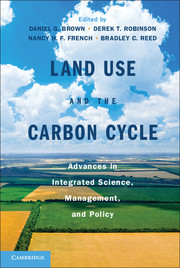Book contents
- Frontmatter
- Contents
- Chapter Authors and Affiliations
- Acknowledgments
- Acronyms
- Part I Introduction
- Part II Measurement and Modeling
- Part III Integrated Science and Research Applications
- 9 Carbon Emissions from Land-Use Change: Model Estimates Using Three Different Data Sets
- 10 A System to Integrate Multiscaled Data Sources for Improving Terrestrial Carbon Balance Estimates
- 11 Simulated Biogeochemical Impacts of Historical Land-Use Changes in the U.S. Great Plains from 1870 to 2003
- 12 Carbon Signatures of Development Patterns along a Gradient of Urbanization
- Part IV Land Policy, Management, and the Carbon Cycle
- Part V Synthesis and Future Directions
- Index
- Plate Section
- References
11 - Simulated Biogeochemical Impacts of Historical Land-Use Changes in the U.S. Great Plains from 1870 to 2003
Published online by Cambridge University Press: 05 February 2013
- Frontmatter
- Contents
- Chapter Authors and Affiliations
- Acknowledgments
- Acronyms
- Part I Introduction
- Part II Measurement and Modeling
- Part III Integrated Science and Research Applications
- 9 Carbon Emissions from Land-Use Change: Model Estimates Using Three Different Data Sets
- 10 A System to Integrate Multiscaled Data Sources for Improving Terrestrial Carbon Balance Estimates
- 11 Simulated Biogeochemical Impacts of Historical Land-Use Changes in the U.S. Great Plains from 1870 to 2003
- 12 Carbon Signatures of Development Patterns along a Gradient of Urbanization
- Part IV Land Policy, Management, and the Carbon Cycle
- Part V Synthesis and Future Directions
- Index
- Plate Section
- References
Summary
Introduction
Extensive research has shown that agricultural land-use practices have substantial impacts on the environment, including (1) release of 50 percent of soil carbon (C) following cultivation of the soil, (2) enhanced soil nitrous oxide (N2O) emissions, (3) reduced soil fertility, (4) increases in nitrate (NO3−) leaching into groundwater and streams, (5) changes in plant production, and (6) changes in energy balance and water fluxes (Pielke et al. 2007). By linking observed detailed land-use data for the U.S. Great Plains over the past 150 years to the DayCent ecosystem model (Parton et al. 1998), this review demonstrates how historical changes in land use have affected soil organic carbon (SOC), soil fertility, plant production, and greenhouse gas (GHG) fluxes. A detailed description of the procedure used to link the observed U.S. Great Plains land-use data with the DayCent model, along with a comparison of observed and DayCent simulated historical changes in crop yields for the major crops (corn, wheat, sorghum, hay, and cotton) is presented by Hartman et al. (2011).
The Great Plains region of the United States is unique because by the time it was settled by Euro-American farmers, many modern institutions for information gathering and data analysis were already in place. The settlement and subsequent ecological transformation of this region is therefore well documented in the U.S. censuses of population and agriculture, which contain detailed data at the county level regarding changes in land use, animal production, yields for crops grown under both dryland and irrigated conditions, economic value of animal and crop raising, and movements of human populations, first on the decadal scale and then every five years for agriculture beginning in 1925. These data have been digitized for the Great Plains and are now publicly available in machine-readable form (Gutmann 2005a, 2005b).
- Type
- Chapter
- Information
- Land Use and the Carbon CycleAdvances in Integrated Science, Management, and Policy, pp. 287 - 304Publisher: Cambridge University PressPrint publication year: 2013
References
- 4
- Cited by



